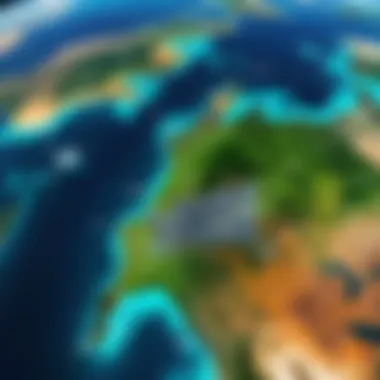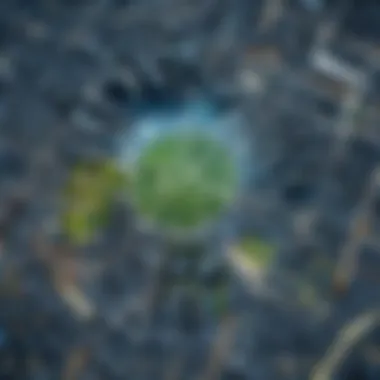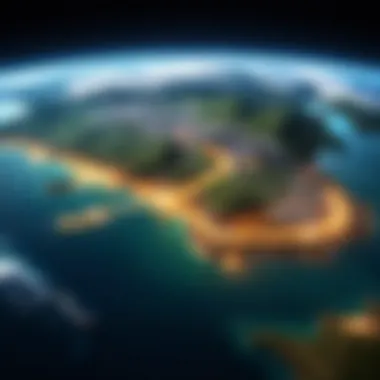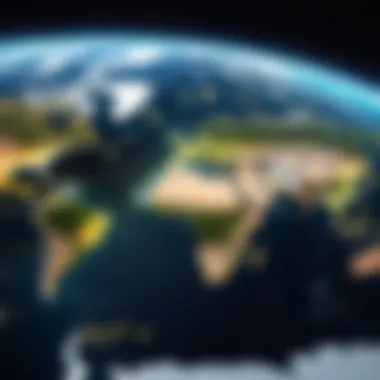Real-Time Satellite Earth Views: Innovations and Impacts


Intro
The world is evolving at a pace that can sometimes leave us breathless. With advancements in technology, specifically in satellite Earth observation, we are finding ourselves equipped with tools and insights that were once the realm of science fiction. Imagine looking at your hometown in real-time from a satellite hovering miles above, gaining a fresh perspective on not just geographical changes, but also urban development, environmental shifts, and even disaster responses. This is no longer a dream; it’s today’s reality that’s revolutionizing multiple sectors.
As we explore the implications and innovations attached to real-time satellite views, it’s crucial to understand the underlying technology. From aerospace engineering marvels to complex algorithms analyzing data, the machinery that makes all this possible is as fascinating as the images it produces. This article will navigate through captivating insights, innovative applications, and the challenges posed by such advanced surveillance, striking a balance between technology and ethics.
Dive deep with us into an exploration unlike any other, illuminating how these high-tech eyes in the sky can reshape our understanding and management of the Earth.
Intro to Real-Time Satellite Earth Views
In a world increasingly shaped by technology, the emergence of real-time satellite Earth views stands as a landmark innovation. This advanced technology enables us to observe our planet from above, offering insights that were once confined to the realm of science fiction. The relevance of this topic extends beyond mere fascination, impacting critical sectors such as environmental science, urban development, and disaster response.
Understanding real-time satellite imagery is essential for recognizing its multifaceted benefits. These views provide an ongoing snapshot of geographical changes, aiding in the monitoring of deforestation, the movement of natural disasters, and urban expansion. Moreover, such technology fosters a deeper awareness of climate change, as it shines a light on environmental shifts that occur over time.
While the benefits are profound, there are also significant considerations. The capacity for real-time monitoring raises questions about data privacy and surveillance, as these satellite capabilities can easily track movement and activities on the ground. Balancing the benefits of enhanced knowledge with ethical constraints is a critical conversation that needs to be part of this exploration.
To encapsulate the essence of the topic, one needs to appreciate its implications and innovations. The advancements in satellite technology present a dual-edged sword—on one side, they offer a powerful tool for positive change; on the other, they necessitate rigorous scrutiny of the ethical dimensions involved. This article aims to unravel the intricate web of real-time satellite Earth views and their implications, ensuring that readers walk away with an enlightened perspective on this crucial subject.
Definition and Overview
Real-time satellite Earth views refer to the continuous observation of the Earth’s surface as captured by satellite technology. These images, which can be processed and analyzed almost instantaneously, provide a remarkable level of detail and immediacy. In contrast to traditional satellite imagery, which may experience delays in processing or transmission, real-time systems are designed for rapid data acquisition and dissemination. This innovation enables stakeholders to make timely decisions based on up-to-date information.
Overall, this technology blends optics and data, transforming raw imagery into actionable intelligence that various sectors—be it agriculture, defense, or urban planning—can leverage effectively.
Historical Context
The roots of satellite imagery can be traced back to the early days of space exploration, with significant milestones marking its evolution. The launch of the first artificial satellite, Sputnik 1, by the Soviet Union in 1957 paved the way for an entire industry dedicated to Earth observation.
In the subsequent decades, several important advancements have appeared:
- The introduction of Landsat in the early 1970s marked the beginning of systematic Earth observation, enabling scientists to capture images of land use and changes over time.
- As technology improved, so did the quality of satellite images, leading to higher resolutions and more detailed views of the Earth.
- The launch of commercial satellites in the 1990s initiated a new era, where private companies began to offer satellite imaging services, expanding access to a wider audience.
More recently, the surge in small satellites and CubeSats has revolutionized the satellite landscape, making real-time observation more accessible and affordable. This shift has opened up new possibilities for various industries, as the ability to monitor the Earth in real-time can now be achieved with much smaller budgets and resources. The journey from rudimentary images to real-time feeds illustrates how far we've come and sets the stage for future innovations in satellite technology.
The Technology Behind Satellite Imagery
Understanding the technology behind satellite imagery is crucial in grasping the broader implications of real-time Earth views. These technologies define the capabilities and applications of what satellites can achieve. Whether it’s for environmental monitoring, disaster management, or urban planning, the underlying technology enables consistent, reliable, and actionable data to be harvested from above.
Types of Satellites Used
Low Earth Orbit Satellites
Low Earth Orbit (LEO) satellites are, in many regards, the workhorses of real-time satellite communication and imagery. Positioned typically between 160 to 2,000 kilometers above the Earth's surface, these satellites have several specific aspects that make them unique. LEO satellites contribute significantly to enhancing the spatial resolution of images, allowing for a sharp focus on smaller areas as compared to their counterparts.
A key characteristic of LEO satellites is their relative proximity to the Earth. This allows for shorter communication delays and enables real-time processing of data—crucial for applications such as monitoring forest fires or tracking floods. The unique feature of LEO satellites is their ability to revisit the same location multiple times in a single day. This can be advantageous when swift updates on environmental changes are required, though the frequent motion can also create management challenges in data handling as satellite paths need to be finely orchestrated.
Geostationary Satellites


On the other end of the spectrum are geostationary satellites, which orbit at an altitude of about 35,786 kilometers. What makes these satellites particularly noteworthy is their ability to maintain a fixed position relative to the Earth's surface. This is a key aspect when considering continuous monitoring of a geographical area, such as observing weather patterns or tracking storm systems.
Geostationary satellites offer a significant advantage in terms of coverage. A single geostationary satellite can cover nearly a third of the Earth’s surface, reducing the need for a multitude of other satellites. However, the unique challenge lies in their lower spatial resolution; the distance degrades the image clarity. Furthermore, the latency in data transmission can be a disadvantage when immediate data processing is required.
Data Transmission Methodologies
Real-Time Data Processing
Real-time data processing is paramount in making satellite imagery truly useful. This process not only simplifies data analysis but ensures that actionable information is readily available without unnecessary lag. One of the critical aspects here is the use of advanced algorithms that can swiftly interpret the raw data received from satellites.
The primary characteristic setting real-time data processing apart is its velocity. Typically powered by high-speed algorithms operating through robust cloud infrastructures, the speed allows for immediate insights—whether that’s assessing the extent of a flood or mapping urban expansion. A unique feature of this methodology is the capacity to integrate data streams from various satellite sources, which can enhance analysis further. However, while this is incredibly beneficial for off-the-cuff analysis, the requirement for top-tier hardware and software can pose challenges in some regions trying to implement such technologies.
Cloud Computing for Data Management
As satellite imagery generates massive volumes of data, cloud computing emerges as an essential element in data management. It offers a flexible, scalable solution to store and process data gathered from satellite feeds. This is particularly important as it allows users to access data from anywhere, facilitating collaboration among different stakeholders involved in Earth observation.
A notable characteristic of cloud computing is its ability to provide processing power on-demand. This makes it a popular choice for researchers and governments that require significant computational resources but may not possess the infrastructure needed to support extensive data analysis. The unique feature of cloud computing in this context is its ease of integration with various analytic tools that can further process satellite data. However, reliance on the cloud also raises questions about data privacy and security, which must be tackled head-on.
"Cloud computing has become the backbone for managing the extensive data streams generated by satellite technologies, effectively breaking down geographical barriers to data access and analysis."
In summary, the technologies behind satellite imagery equip various sectors with the means to observe and respond to changes on Earth dynamically. Understanding these technologies helps elucidate how such data can be transformed into actions that influence environmental, social, and economic landscapes.
Applications of Real-Time Satellite Earth Views
The ability to observe Earth in real-time via satellites opens a Pandora's box of possibilities across various sectors. These applications are not just interesting anecdotes of technology; they are integral to our understanding and management of the planet. From environmental monitoring to disaster response, the implications for society, businesses, and governance are profound. Each application leverages satellite technology to assess conditions and create actionable insights that can lead to more informed decision-making.
Environmental Monitoring
Oceanography Studies
Oceanography studies benefit immensely from real-time satellite images, particularly in monitoring temperature variations, current flows, and biological phenomena. Satellites can cover vast stretches of ocean, enabling scientists to track changes that might take ground-based methods ages to gather. This capability makes it a critical choice in discussions about climate change and marine ecosystems. The unique aspect of oceanography facilitated by satellite imagery is its ability to provide data at an unprecedented scale and scope. However, while this method is beneficial, there are inherent challenges like varying resolution and potential data gaps when it comes to finer details.
Deforestation Tracking
Deforestation tracking is another area where real-time satellite views shine. The capability to monitor forested regions continuously helps various stakeholders, including governments and environmental organizations, make timely interventions to prevent further loss of biodiversity. The key characteristic of this application lies in its precision and rapid reporting. Emerging trends and patterns become evident sooner, allowing for informed decision-making. Nevertheless, one must consider the limitations, as factors like cloud cover can obscure imagery and hinder tracking efforts in certain regions.
Urban Planning and Development
Urban planning has seen a dramatic shift thanks to real-time satellite imagery. From assessing land use to infrastructure development, satellites provide cohesive data that informs city planners' decisions.
Real Estate Development
Real estate developers leverage satellite views to identify promising locations, assess neighborhood trends, and visualize land characteristics before investing. The advantage of using satellite imagery in this context is the ability to access comprehensive data on zoning, topography, and urban sprawl. This can lead to more sustainable future developments. However, the unique feature can sometimes translate into complexities due to interpretation of data; misreading satellite information can lead to costly mistakes.
Traffic Management Solutions
Traffic management is a growing concern in urban settings. Real-time satellite views can monitor traffic patterns, allowing for dynamic adjustments to traffic light systems or public transportation routes. One major benefit of this technology is its real-time response capability. Decision-makers can be alerted instantly to congestion and reroute flows where necessary. The downside, however, includes the initial costs for the required infrastructure and continuous data management.


Disaster Management and Response
When calamity strikes, the need for precise information is paramount. Satellite imagery plays a critical role in this context.
Earthquake Damage Assessment
In the aftermath of an earthquake, assessing damage is crucial for effective recovery efforts. Satellite images can provide rapid insights into affected areas, revealing the extent of damage to buildings and infrastructure. The unique feature of this application is its speed; data can be processed and made available quickly, which is invaluable in emergency situations. Yet, reliance solely on satellite imagery can miss the nuances captured through ground assessments, presenting a trade-off in understanding the human impact.
Hurricane Tracking and Recovery Efforts
Hurricanes pose a significant threat, and satellites become essential tools in tracking their path and estimating potential impacts. They provide authorities with real-time data to facilitate timely evacuations, as well as assess recovery efforts post-disaster. The key aspect of this application is the predictive modeling that continues to improve with advancements in satellite technology. However, one must prepare for challenges like data interpretation errors which could lead to either undue panic or insufficient caution.
Challenges in Real-Time Satellite Imagery
The leap into real-time satellite imagery brings along a mix of exhilarating possibilities along with several challenges that cannot be ignored. As the technologies evolve, it becomes evident that while we can visualize Earth in near real-time, there are fundamental issues that need addressing. The implications of these challenges touch various areas including privacy, security, and technical capabilities, each influencing how we utilize satellite data.
Data Privacy and Security Concerns
Surveillance Issues
Surveillance emerges as a critical factor here, considering real-time satellite images can track individuals and collect personal data without consent. This leads to potential misuse by various entities, including governments and corporations. One key characteristic of surveillance issues is the fine line between safety and intrusion. It is a hot topic, especially as folks grow wary of how much they are being monitored. In this article, recognizing surveillance concerns is beneficial as it prompts discussions on protective measures for individual rights.
Furthermore, the unique feature of surveillance through satellites makes it a double-edged sword. On one hand, it can aid in security and disaster response; on the other, it can infringe upon personal privacy. We must weigh these advantages and disadvantages carefully as we, as a society, navigate the complexities presented by surveillance technology affecting daily lives.
Legal and Ethical Boundaries
Delving into the legal and ethical boundaries also paints a robust picture of the challenges involved in satellite imagery. This segment underscores the importance of setting regulations that govern satellite operations and data usage. Key characteristics include the tension between technological capabilities and the laws designed to protect individuals. Amid various legal frameworks, it’s a balancing act striving to protect people’s interests while embracing innovation.
In this article, highlighting these legal boundaries serves as an invaluable guide for understanding where innovation meets regulation. Its unique feature lies in the ability to provoke critical thought about current laws. These discussions often reflect on what’s permissible versus what should be restricted, presenting both advantages in spearheading necessary changes and disadvantages in stifling technological progress.
Technical Limitations
Resolution Challenges
Resolution challenges are more than just a technical hiccup; they affect the quality and reliability of the imagery we obtain. The ability to view fine details from space is limited by the technology used in satellites, which can lead to misinterpretations or loss of crucial data. A key characteristic of these challenges is their direct impact on operational effectiveness—higher resolution means better decision-making capabilities.
For this article, discussing resolution challenges shines a light on the persistent necessity for advancing satellite technologies. The struggle remains between the desire for high quality and the technical restrictions of current systems, bearing both advantages in improved intelligence gathering and disadvantages when detail might be overlooked during crucial assessments.
Data Overload and Management
Lastly, data overload and management present monumental challenges that also cannot be brushed off. Satellites collect immense amounts of data, and effectively managing this data dictates how well we harness its potential. The key characteristic of this challenge is the necessity for robust processing, storage solutions, and analytical tools to sift through substantial datasets.
This segment in the article plays a significant role in fostering awareness around the infrastructure needed to support data accumulation. A unique feature here involves examining the potential consequences of not having proper management systems in place, which can lead to missed opportunities and delayed response efforts. While there are advantages to having more data at our fingertips, without proper management, it can quickly become less effective and impractical.
The Future of Satellite Earth Observation
The world of satellite imagery is evolving at breakneck speed, and the future holds even greater promise. As we look ahead, it’s fascinating to consider the implications of the technologies being harnessed for satellite Earth observation. This article highlights how next-generation innovations can redefine several sectors, offering not only improved monitoring capabilities but also more efficient data usage and analysis. With these advancements, we unlock a treasure trove of possibilities that can tackle some of our most pressing global challenges.


Emerging Technologies and Innovations
Advancements in Imaging Technology
A noteworthy aspect of advancements in imaging technology lies in the enhanced resolution capabilities. With new sensors and imaging techniques, satellites can now capture images with an astonishing level of detail. This high-resolution imagery dramatically improves our ability to analyze various environmental and urban phenomena.
One key characteristic of this technology is its ability to provide near-real-time updates, which helps decision-makers respond swiftly to ever-changing situations. For instance, during natural disasters, rapid imaging can inform rescue operations and resource distribution more effectively.
While the advantages are significant, there are challenges too. The sheer volume of data generated can overwhelm analysts, necessitating advanced algorithms for efficient data processing. Still, with a proper infrastructure in place, the benefits clearly outweigh the drawbacks.
Artificial Intelligence Integration
Artificial Intelligence (AI) is another game-changer in the field of satellite observation. It contributes significantly by automating data analysis processes, identifying patterns that might go unnoticed by human observers. This characteristic makes AI a powerful ally in tackling complex global issues like climate change.
The unique feature of AI integration is its ability to perform predictive analytics, which helps in forecasting trends related to environmental changes or urban growth. For example, AI algorithms can detect changes in vegetation cover or urban sprawl, providing crucial insights for sustainable planning. However, while AI enhances capabilities, it does raise questions regarding accountability and accuracy — a small error in AI analysis can lead to misguided conclusions.
Potential New Applications
Global Health Monitoring
One fascinating potential application of real-time satellite data is in global health monitoring. Utilizing satellite imagery, health practitioners can track disease outbreaks, monitor environmental factors influencing health, and identify areas susceptible to health crises. The characteristic of this application that stands out is its capacity for widespread surveillance with relatively low operational costs.
The unique feature here is the ability to correlate health data with environmental conditions, helping to pinpoint causative factors. However, this capability isn't without its downsides. Privacy concerns arise, as constant monitoring can lead to misuse of information if not done ethically.
Agricultural Optimization
In agriculture, satellite technology promises significant optimization benefits. Remote sensing allows farmers to monitor crop health, soil conditions, and moisture levels from above, leading to more precise farming practices. The critical aspect of agricultural optimization is its potential to enhance yield while minimizing resource use. This balance is increasingly vital in a world facing food security challenges.
The unique feature of this application is its ability to enable precision agriculture, where farmers can make data-driven decisions tailored to specific areas of their fields. On the flip side, reliance on this technology requires upfront investment, which might not be feasible for all farmers, adding a layer of inequity in access.
"The advancements in satellite technology bring us closer to addressing complex global challenges, but they also require thoughtful consideration of ethical implications."
Finale: The Importance of Real-Time Satellite Earth Views
The realm of real-time satellite Earth observations stands at a pivotal intersection of technological advancement and societal needs. As we delve deeper into its significance, it becomes evident that these tools carry substantial weight in various sectors, from the way cities are structured to how natural disasters are managed. The implications of harnessing satellite imagery extend far beyond mere data collection; they reshape our understanding of the world.
When we discuss the importance of real-time satellite views, several specific elements spring to mind. These tools enable unprecedented transparency in environmental monitoring, which in itself is invaluable for addressing issues like climate change, biodiversity conservation, and resource management. For instance, having timely data can help usher in swift policy changes that can mitigate the effects of pollution or deforestation, making a direct positive impact on our planet.
The applications extend into urban planning, where the integration of satellite imagery in planning procedures offers planners and developers a bird's-eye view, allowing for better infrastructure design and zoning decisions. In addition, in disaster management contexts, instantaneous satellite data provides responders with critical insights. When a hurricane approaches, the ability to assess damage in real time could be a lifesaver, affecting rescue operations and resource allocation.
"Real-time satellite imagery is not just about seeing; it’s about understanding, anticipating, and responding to the challenges on Earth." The economic implications should also be highlighted. There's a burgeoning ecosystem of startups and established firms leveraging satellite technology for new services. This brings job creation and innovation opportunities to the forefront.
However, this importance is laced with challenges that require our careful consideration, such as data privacy and the ethics associated with the use of surveillance technologies. As we embrace these advancements, we also must address potential pitfalls, like the misuse of satellite data, making discussions around legal frameworks and ethical standards critical.
In summary, real-time satellite Earth views represent a powerful blend of technology and necessity that can deliver substantial benefits. By emphasizing their importance, we acknowledge our responsibility to harness them wisely and ethically.
Summary of Findings
The journey through real-time satellite Earth views exposes various facets of how technology intertwines with our everyday lives. Key findings from our exploration include:
- Transformative Applications: Significant advancements in environmental monitoring, urban planning, and disaster management showcase this technology's profound impact.
- Data-rich Insights: Real-time data enhances decision-making processes and disaster response strategies, which can help save lives.
- Ethical and Legal Challenges: The dual nature of satellite data—beneficial yet also problematic—calls for new frameworks and policies to safeguard privacy while fostering innovation.
Call to Action for Future Research
Looking ahead, the field of real-time satellite Earth observation presents tantalizing opportunities for future research. We should advocate for:
- Enhanced Multidisciplinary Collaboration: Bridging technologists, urban planners, environmentalists, and policymakers can yield richer solutions.
- Focus on Ethics: Establishing strong ethical guidelines around satellite data usage will ensure responsible integration into society.
- Investment in Technology: Continued investment in new imaging technologies—and how they interact with existing data management systems—will keep innovation flowing.
The path ahead is laden with possibilities, excitement, and challenges. It is thus imperative that we continue to investigate and expand our knowledge in this evolving field.







